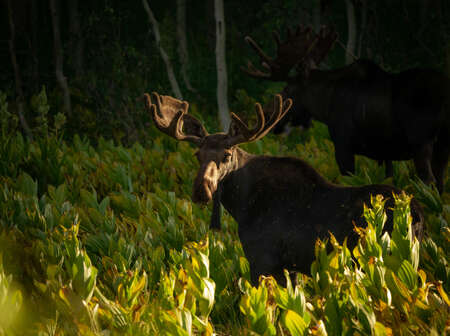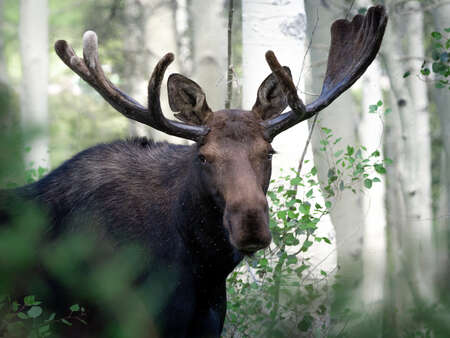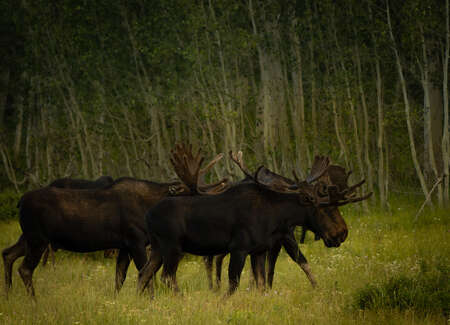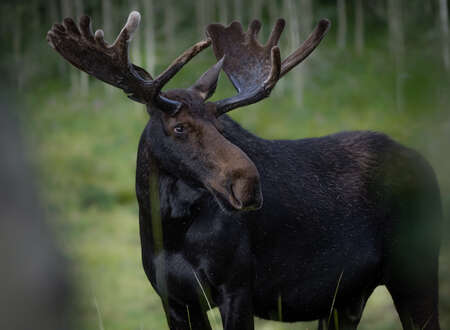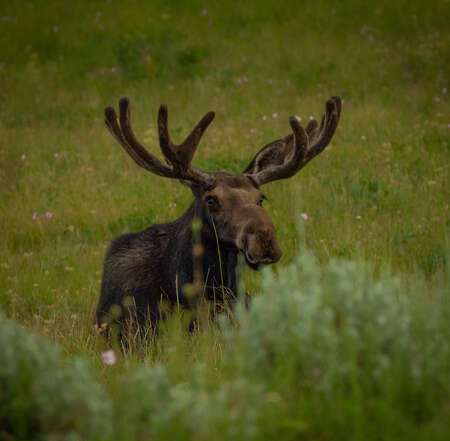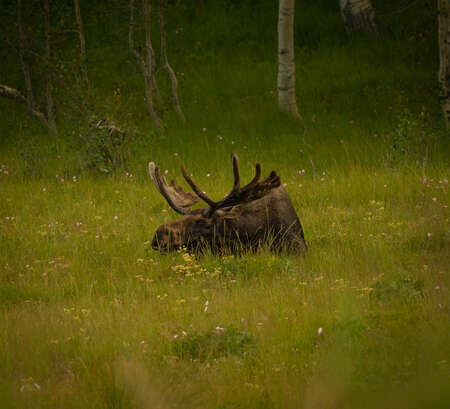AMONG THE MOOSE
I spent two evenings on foot following a migrating moose population with my OM-D E-M1 Mark III camera body and 100-400mm 5.0-6.3 IS lens slung over my shoulder. Mid summer in the mountains is my favorite season for vibrant wildflowers and lush forests, but it's a difficult time to find wildlife. The high temperatures typically drive animal populations to higher elevations where they seek shelter from the sun in shaded forests and canyons. After a few slow weeks without any wildlife sightings, I received word that an unusually large group of moose were seen migrating together across a series of alpine meadows. I figured it was the perfect opportunity to put the new 100-400mm 5.0-6.3 IS to the test. I knew I’d have to cover some distance to catch up to these moose, and bringing along multiple camera bodies and lenses wasn’t an option if I wanted to keep my pack light. Despite offering an 800mm equivalent field of view, the 100-400mm 5.0-6.3 IS zoom lens is impressively compact and lightweight, so I figured it was the perfect lens for upcoming days on foot in the field.
DAY ONE
Luck was on my side the first evening. I found myself some moose to photograph in basically no time at all. After only about an hour of leisurely scouting the perimeter of an alpine forest, I came upon three adult moose feeding on brush deep within the trees. It was still quite early in the evening, so the bugs were out in force. There were clouds of gnats and mosquitoes so dense I could hardly open my mouth or breath in too deeply or I’d inhale some. The relentless swarms of bugs were a nightmare, and they visibly irritated the moose which made their behavior a little tricky to anticipate. Approaching a wild moose is dangerous and not something I encourage or practice, and their obvious bad mood emphasized the need for safety. Instead of approaching, I made my body posture small and waited quietly upwind for the moose to come within range to start photographing.
While I crouched behind the aspens and brush, I was grateful for the 800mm equivalent field of view the 100-400mm F5.0-6.3 IS offered me. I was able to get some intimate, detailed shots of the bull moose while maintaining a safe distance. The lens had no problem autofocusing through the bugs and dense brush, and stayed pin sharp as the moose moved through the trees.The bugs and added some welcome detail and drama to the scene and really show just how much these animals have to endure as they work to survive in some of the wildest environments on Earth.
Prior to the introduction of the 100-400mm F5.0-6.3 IS to the Olympus lens lineup, the longest telephoto lens in my kit was the 300mm F4.0 IS PRO prime lens. The 300mm prime has been my go-to lens for the past few years, which meant I grew accustomed to having to physically move around in order to zoom in or out on my subject. Being able to use a zoom lens with such a considerable amount of focal length was nothing short of luxurious for me. I could stand my ground and remain almost motionless in order to make the moose feel as comfortable as possible in my presence. I was able to spend the entire evening watching the moose without disturbing them.
When I finally lost the light and turned back to my car, I couldn’t stop smiling.
DAY TWO
Luck was not on my side when the second evening began. A storm rolled in off the mountains shortly after I began scouting, and left dreary overcast skies in its wake. Luckily, my camera body and lens are weatherproof so the rain wasn’t devastating, but it definitely made for some less than ideal lighting and hiking conditions. I hiked for miles that evening without finding any indication of moose in the area. I was grateful for the fact that at least my camera and lens were light enough to hardly be a burden on my increasingly exhausted body. But after slogging through mud and dense brush for longer than I cared to, I decided it was time to cut my losses and start heading back to my car.
During the last quarter mile stretch before I reached the car, I spotted a small herd of cattle grazing lazily in a meadow. I was quite confused to see cows so high in the mountains, as far as I know that area was not close to any cattle range. Curiosity got the best of me and I decided to approach them to investigate. The clouds started to break just as I was getting closer, and suddenly I realized this wasn’t a herd of cows at all. It was a group of moose. Eight adults in total - more than I’d ever seen in one place at one time.
I immediately backed off and found a spot on a small rise overlooking the meadow. From there, I photographed the moose lazily making their way to the other end of the meadow to eventually bed down. As they moved toward me and then away from me again, I was able to zoom in and out to effortlessly capture their photos. Once again, I was incredibly pleased with the level of detail the 100-400mm F5.0-6.3 IS captures even in low light conditions.
After the sun finally disappeared and I felt satisfied with my shots, I put down my camera and took a moment to linger on the rise watching the silhouettes of the bedded down moose. A cool evening breeze blew down from the mountains carrying the scent of pine forest and summer wildflowers. I could hear the moose gently sighing and snoring as they drifted off to sleep. Night settled in the mountains, and I could not have been happier as I reflected on the magic of the two days before.
Instagram: @brookelittlebear
Brooke is a wildlife photographer based out of Salt Lake City, Utah. She has always been a lover of animals, and when she first began shooting she was naturally hooked on photographing wildlife right from the start. Her ultimate goal is to photograph all the core species of megafauna found in North America. When Brooke is not actively photographing, tracking, or scouting for wildlife, you can find her snowboarding.
